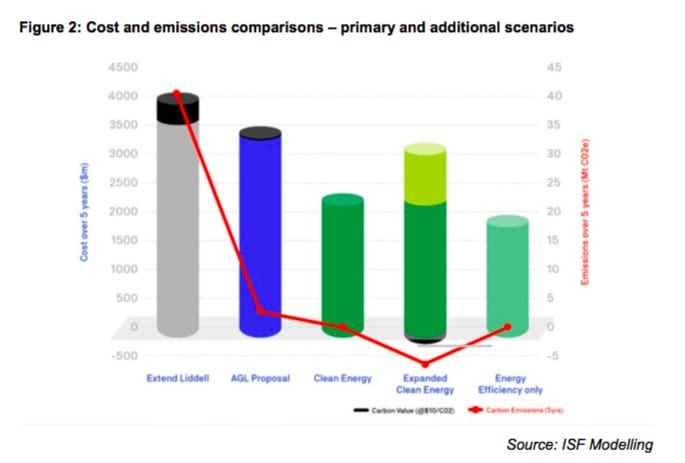AGL’s plans to close the Liddell coal plant and replace it with renewables, storage and gas peaking plant will deliver cost savings of around 20 per cent, but those savings could have doubled if more attention had been given to using energy in a smarter way.
Chris Dunstan, from the Institute of Sustainable Futures, says if energy efficiency measures had been used as a substitute for the ageing and increasingly decrepit Liddell coal generator, then the costs would have reduce to just $56/MWh, rather than $83/MWh in AGL’s proposal and $106/MWh if Liddell’s operations were extended for another five years.
“Consumers should do a lot better our of the Liddell closure than AGL’s plan,” Dunstan told RenewEconomy on Monday, adding a pure “clean energy package” would also remove all emissions.
But he said the criticism should not be laid at the feet of AGL – even though its commitment to demand response initiatives and energy efficiency was minimal – but with an electricity market that gave little incentive to big utilities like AGL to be more efficient.
“It requires response from government – to ensure we have got the regulatory settings in the NEM (National Electricity Market) to deliver the least cost outcomes to consumers, because that is what missing,” Dunstan says.
“Cheaper options are simply being ignored because we don’t have a market that facilitates least-cost outcomes.”
It has long been accepted that the cheapest cost of energy, and the cheapest cost of abatement, is for the energy that is not used.
But Australia has long been a laggard in energy efficiency – in the energy market, in housing and in transport – and any schemes that do exist already have a “house full” sign on them, such as the ‘white certificate’ schemes in states like NSW and Victoria.
Dunstan was a lead author of an ISF report released last month, and commissioned by the Australian Conservation Foundation, that looked at alternatives for Liddell (See Beyond Coal: Alternatives for extending the life of the Liddell power station).
It noted, as AGL has concluded, that keeping the generator open was the most costly and least efficient option.
AGL has proposed to reduce those costs by building a scheme around 1.6GW of renewables, 750MW of gas peaking plant, 250MW of battery storage, and 300MW of demand response.
Around half of those initiatives are committed, but the fate of the other half rest in the response of other market players, and to the outcomes of government policy.

The ISF modelling showed that by far the cheapest options were based around a “clean energy package”, one with a minimal amount of renewables and a lot of energy efficiency and demand management, and one with extra investments in solar thermal and biomass.
The cheapest option of all was just using energy efficiency measures – 1,200MW in total.
Dunstan says that currently big generators have little incentive to ensure that prices go down (apart from the lingering threat of mass defection).
But this issue needs to be addressed – not just because of the continuing falls in battery storage and renewable energy costs, but also if grid prices continue to rise, or even if they fail to fall.
“The response to the proposed closure of Liddell Power Station should be linked to clear policy objectives around reliability, affordability, sustainability and minimising economic shocks for the local community and the nation,” the ISF report said.
And it also noted that it was not the responsibility of AGL to replace the capacity of Liddell – that would not encourage competition in the market.
“The Commonwealth government should adopt competitively neutral policies that treat all market participants fairly. Singling out one company to respond would not provide an effective government policy and framework to transition the whole electricity sector,” it says.
Dunstan, however, says there is a lot of work to be done to convince policy makers that energy efficiency, or even demand response, is a winning proposition – even if the savings are obvious.
“People don’t seem to be able to get their head around it,” Dunstan says.









